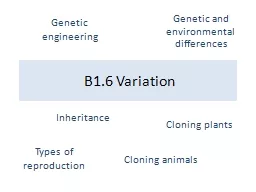

Cloning plants Types of reproduction Genetic and environmental differences Genetic engineering Cloning animals Inheritance Genetic information is in the nucleus of cells Inside the nucleus are ID: 934257
Download Presentation The PPT/PDF document "B1.6 Variation Inheritance" is the property of its rightful owner. Permission is granted to download and print the materials on this web site for personal, non-commercial use only, and to display it on your personal computer provided you do not modify the materials and that you retain all copyright notices contained in the materials. By downloading content from our website, you accept the terms of this agreement.
Slide1
B1.6 Variation
Inheritance
Cloning plants
Types of reproduction
Genetic and environmental differences
Genetic engineering
Cloning
animals
Slide2Inheritance
Genetic information is in the
nucleus of cellsInside the nucleus are chromosomes made up of DNA – humans have 46 chromosomes (23 pairs) Genes are a section of DNA and control enzymes and proteins made in your body
Genes are passed on to you in the sex cells (gametes) from your parents – they come in pairs
Slide3Types of reproduction
Sexual reproduction
Male sex cell and female sex cell
Risky as the two have to meetBUT provides genetic variation important for survival E.g. Mammals, birds
Asexual reproduction
One parentNo genetic variation – clonesCells of body reproduce asexually – divide in two for growth and repair E.g. Bacteria, strawberries
Advantages
– allows evolution, variation, increases chances of species survival
Disadvantages
– need to find a partner, waste energy. Waste in producing gametes, slower
Slide4Genetic and environmental differences
Nature –
genetic variety E.g. Eye colour, gender, shape of nose Nurture – environmental variety E.g. Scars, accents, drinking when pregnant
Combined causes of varietyE.g. Height, weightInvestigating variety: scientists study twins adopted by different families compared to identical twins brought up together and non-identical twins
Slide5Plant cloning
Cuttings
Remove a small section of the plantNew roots and shoot will form to give you a new plantRooting powders and moisture will help the process Quick and cheapGenetically identical plantsUsed commercially for orchids and fruit trees
Tissue culture
Expensive but allows thousands of new pants from tiny piece of plant
Use plant hormones to make a small group of cells produce a big mass of identical plant cellsUsing hormones these can then forma new plant
This guarantees all plants will have the desired characteristics
Slide6Animal cloning
Embryo cloning
Best cow given fertility hormones to produce lots of eggs and fertilise from best bullDivide each embryo into individual cells - Each cell grows into an identical embryo in the labTransfer embryos into surrogate mothers - Identical cloned calves born Adult cell cloning
Advantages: Save animals from extinction, Bring back prized animals, Clone genetically engineered, medically useful animals (e.g. Those with useful proteins in their milk) Disadvantages: Could lead to cloning humans – ethics? Abuse of science – cloning for organs, Reduces variety –species less able to adapt if there is a change (usually some of the species will survive and reproduce but not if we are all clones)
Advantages
: high quality embryos taken to poor places and produce lots of milk / meat. Can make lots of identical copies of genetically modified embryos that produce genetically useful compounds
Slide7Genetic engineering
Changing the genetic material of an organism
A gene is taken from one organism and transferred into the genetic material of a different organism
Human engineering:Genetic diseases can be very seriousIt might become possible to insert ‘healthy’ genes into the affected cells using genetic engineering
Genetic engineering – insulin
Slide8Exam questions
Slide9Slide10Slide11Slide12[6 marks]
Slide13Slide14Slide15